The feudal society of ancient China embraces a deep sense of clan. Very often a family or several families with the same family name settle down in one village, and establish their own family temple to offer sacrifice to their ancestors. This family temple, commonly known as "ancestral hall", includes temples, central ancestral temples, branch ancestral temples and family ancestral temples.
● Chen Clan Academy
● Guangyu Ancestral Hall
● Huangge Mai Clan Ancestral Hall
● Liang Clan Ancestral Hall
● Peace and Prosperity Academy
● Zeng Clan Ancestral Hall
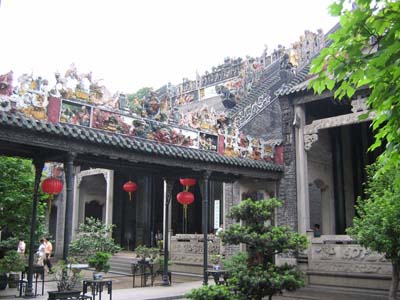
Built at the end of Qing Dynasty (1616-1911), this academy is known world-wide for its exquisite decoration and craftsmanship.
The Chen Clan Academy, commonly known as the Chen Clan Temple, is a national-level protected cultural heritage site, and houses the Guangdong Museum of Folk Arts. Construction of the Chen Clan Temple started in the 14th year of the reign of Emperor Guang Xu of the Qing Dynasty (1888) and was completed in the 20th year of the reign (1894). Located beyond the western gate of the town of Guangzhou in the Qing Dynasty, it was a shared clan temple built with donations from Chen clan members in 72 counties in Guangdong Province. The Chen Clan Academy features an architectural style typical of ancestral halls in Lingnan. It's the largest, most sumptuously decorated and best preserved traditional structure in Guangdong Province, dubbed the gem of Lingnan artistic architecture.
The Chen Clan Academy is a conglomeration of Guangdong's folk architectural styles and features an ingenious application of decorative arts, such as wood, brick and stone carvings, lime-clay mixtures, pottery sculptures, iron castings, and paintings, all of which are masterpieces of folk arts with different themes, vivid designs, rich colors, and consummate workmanship.
In 1959, the People's Government converted the Chen Clan Academy into the Guangdong Museum of Folk Arts, which collects, studies and displays folk handicrafts made in Guangdong and the rest of the country during the bygone dynasties. The museum showcases scores of different types of valuable artifacts and handicrafts, such as pottery, embroidery and sculptures, which reflect Lingnan's folk customs. These exhibits contain a high value for research and appreciation.
※ Opening hours: from 8:30 to 17:30
※ Admission: RMB10; no ticket sale after 17:00
※ Transportation:
· Metro: take Line1 to the station of Chen Clan Academy
· Bus: take Line 85, 88, 104, 107, 128, 193, 196, 204 and 275 to the station of Chen Clan Academy
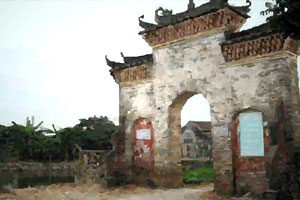 Located in the Qiangang Village, Taiping Town, Guangyu Ancestral Hall is an ancient complex whose construction period is definite. It is called "A Very Valuable Architectural Specimen" by Mai Yinghao, a well-known a archaeologist. It is said that after Lu Xiufu, Prime Minister in the Southern Song Dynasty (1127-1279) was martyred in Yamen, Guangdong, a part of the tribe who once migrated to the south fled here and settled down. A few hundred years later it turned into Qiangang Village. Therefore, Guangyu Ancestral Hall is Lu Clan Ancestral Hall.
Located in the Qiangang Village, Taiping Town, Guangyu Ancestral Hall is an ancient complex whose construction period is definite. It is called "A Very Valuable Architectural Specimen" by Mai Yinghao, a well-known a archaeologist. It is said that after Lu Xiufu, Prime Minister in the Southern Song Dynasty (1127-1279) was martyred in Yamen, Guangdong, a part of the tribe who once migrated to the south fled here and settled down. A few hundred years later it turned into Qiangang Village. Therefore, Guangyu Ancestral Hall is Lu Clan Ancestral Hall.
On December 1, 2003, the restored Guangyu Ancestral Hall won the first place in "Outstanding Project Award" of UNESCO Asia-Pacific Heritage Conservation Award. This was the first time that China had won the first prize.
※ Transportation:
· Take the direct coach in Conghua Coach Station
· Drive three kilometers along Shenqi Road from No.105 Highway
· Drive along No.105 Highway (Guangcong Road) to the crossroad of Taiping Town, turn to No.118 Provincial Highway toward Zengcheng, and turn to Xisha Main Road when arrive at the Shaxi juncture.
● Huangge Mai Clan Ancestral Hall
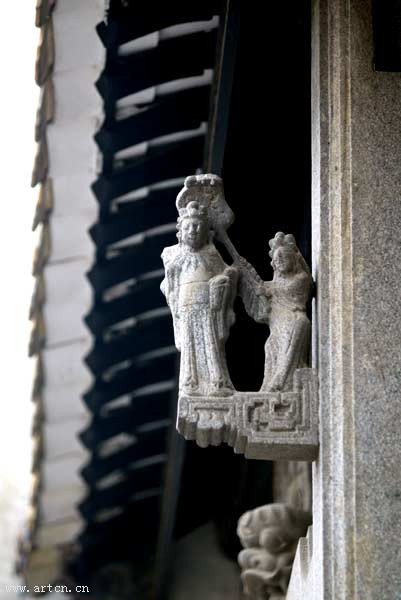 Located in Lianxi Village, Huangge Town, Nansha, Huangge Mai Clan Ancestral Hall was built to worship Mai Bida, the ancestor who set up this village. First built in the Yuan Dynasty (1206-1368), repaired in the Ming (1368-1644) and Qing (1616-1911) dynasties, and rebuilt in the 34th year of the reign of Qing Emperor Guangxu Qing dynasty, Ding (1897), it is the largest-scale existing ancient ancestral hall in Nansha .
Located in Lianxi Village, Huangge Town, Nansha, Huangge Mai Clan Ancestral Hall was built to worship Mai Bida, the ancestor who set up this village. First built in the Yuan Dynasty (1206-1368), repaired in the Ming (1368-1644) and Qing (1616-1911) dynasties, and rebuilt in the 34th year of the reign of Qing Emperor Guangxu Qing dynasty, Ding (1897), it is the largest-scale existing ancient ancestral hall in Nansha .
※ Transportation:
Metro: take Line 4 to the station of Huangge Motor City
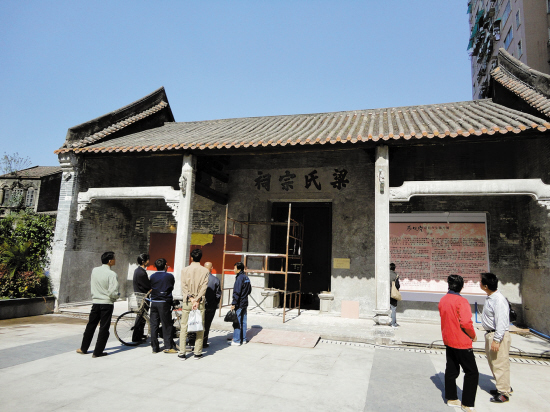 Situated in the northeast of Fengyuang Road, Liang Clan Ancestral Hall was recorded to be first built in the Ming Dynasty (1368 – 1644) according to the stone inscription, and now becomes one of the ancestral halls reserved in a complete way in Pantang. With a width of 3m, Liang Clan Ancestral Hall appears regular and symmetrical, and has a broad courtyard. Compared to other ancestral halls, it presents an extraordinary style.
Situated in the northeast of Fengyuang Road, Liang Clan Ancestral Hall was recorded to be first built in the Ming Dynasty (1368 – 1644) according to the stone inscription, and now becomes one of the ancestral halls reserved in a complete way in Pantang. With a width of 3m, Liang Clan Ancestral Hall appears regular and symmetrical, and has a broad courtyard. Compared to other ancestral halls, it presents an extraordinary style.
You can also visit the Litchi Bay Steam in front of the ancestral hall, where you may enjoy the picturesque sceneries of Xiguan and listen to the Yue Opera performed by Sihuo Troupe. A brief introduction to the Litchi Bay Steam will be provided by the tour guide. The boat takes about 20 minutes to the Litchi Bay Lake.
※ Location: the northwest of Fengyuan Road, Litchi Bay District
※ Transportation:
Bus: Take Line 55, 74 8, 25, 2, or 66 and get off at the station of Pantang
● Peace and Prosperity Academy
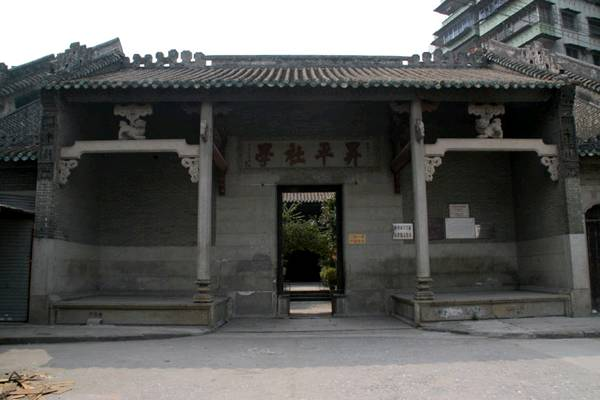 Departing from the Baiyun Lake, it takes about 15 minutes to go to an ancient hall by car- Peace and Prosperity Academy, one of the provincial-level cultural relic protection units. It is an ancestral-hall-like architecture with three courtyards and five bedrooms. The current site was built in the 22nd year of the reign of Emperor Daoguang (1842), initiated by Li Fang, a first-degree scholar in Shijing Village.
Departing from the Baiyun Lake, it takes about 15 minutes to go to an ancient hall by car- Peace and Prosperity Academy, one of the provincial-level cultural relic protection units. It is an ancestral-hall-like architecture with three courtyards and five bedrooms. The current site was built in the 22nd year of the reign of Emperor Daoguang (1842), initiated by Li Fang, a first-degree scholar in Shijing Village.
Prior to the Opium War, this academy served as a site for masters to impart Confucius, etiquette, and custom, and for gentries to preach harmony. During the Opium War, Peace and Prosperity Academy played the leading role in the struggles against aggression participated by the students in the academies and patriotic people, namely: Guangzhou people setting fire to the western office building in 1842, fight against rent in 1844, deportation of Liu Xun, a prefect in 1845, and fight for city.
In the eyes of residences of Shijing Street, it is a place to witness the history and enjoy the ancient architecture. It can be visited for free, with a reading room inside.
※ Address: 11, Shengpingxia Street, Shijing Village, Baiyun District, Guangzhou
※ Transportation:
Take the No. 556 and 830 bus and get off at Shijing Town.
Located in Longgang Village, Zhongluotan Town, Zeng Clan Ancestral Hall is also known as Mourning Hall. First built in the Ming Dynasty (1368-1644), and rebuilt in the period of the reign of the Qianlong Emperor (1735 – 1796). This 600 years' old Ancestral Hall covers an area of 966 sqm. Featuring gray lime decorated ridge tile, green bamboo cylinder styled tile roof, plainly- engraved eave tile, it is a well-preserved architecture of the Ming Dynasty style in Guangzhou.
※ Location : Longgang Village, Zhongluotan Town, Baiyun District
All materials marked with "source: English.gz.gov.cn" on this website (including but not limited to text, photographs, audio and video materials) are the copyrighted property of Guangzhou International (the official website of Guangzhou Municipality). Without prior authorization from Guangzhou International, any media, website, organization or individual shall not transmit, interlink, distribute or republish such materials in any form. Any media and website authorized to republish such materials shall mark them with "source: Guangzhou International (English.gz.gov.cn)". Infringement of these copyrights will result in legal action.







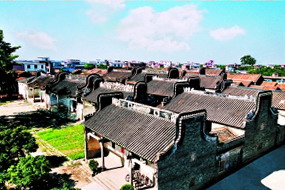 ● Zeng Clan Ancestral Hall
● Zeng Clan Ancestral Hall